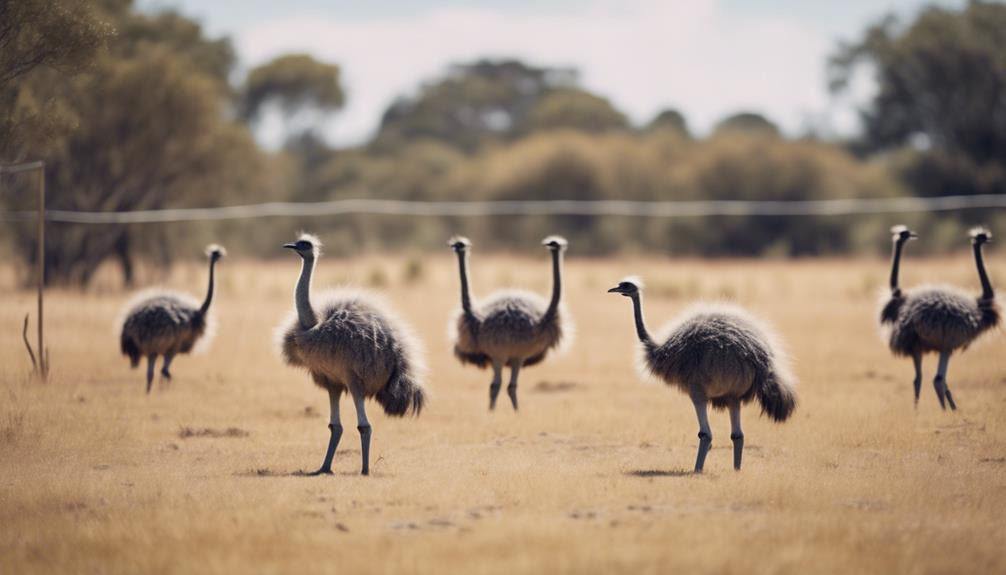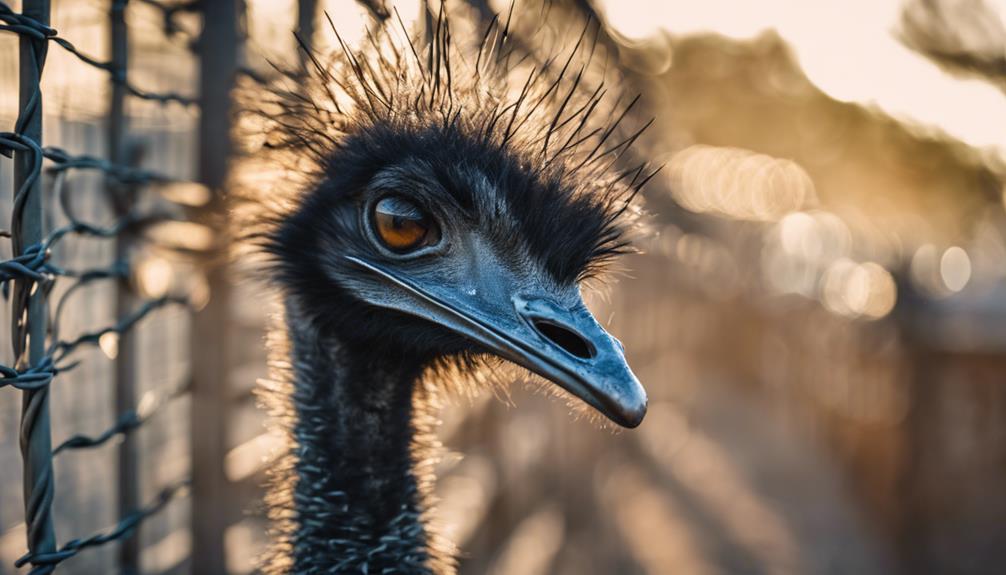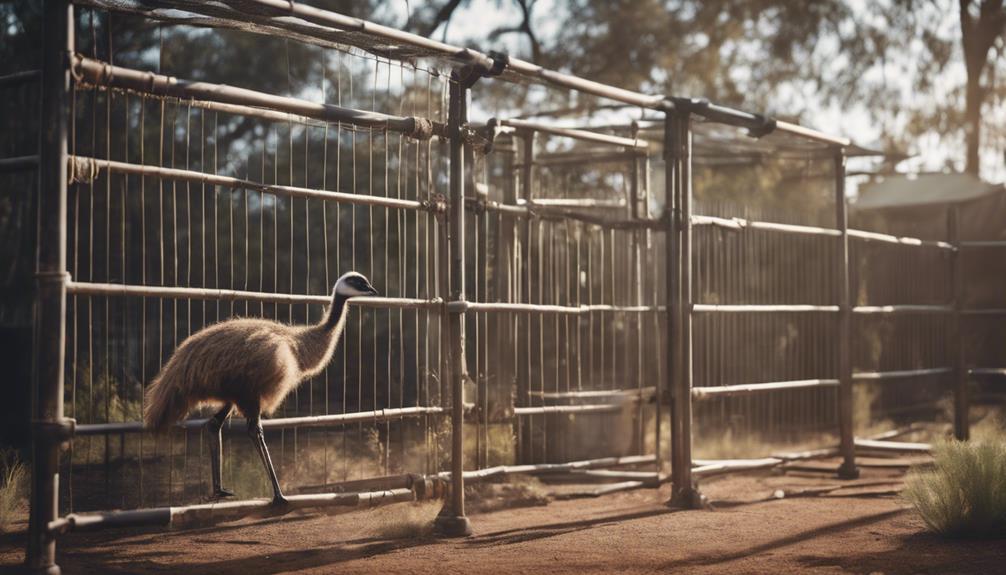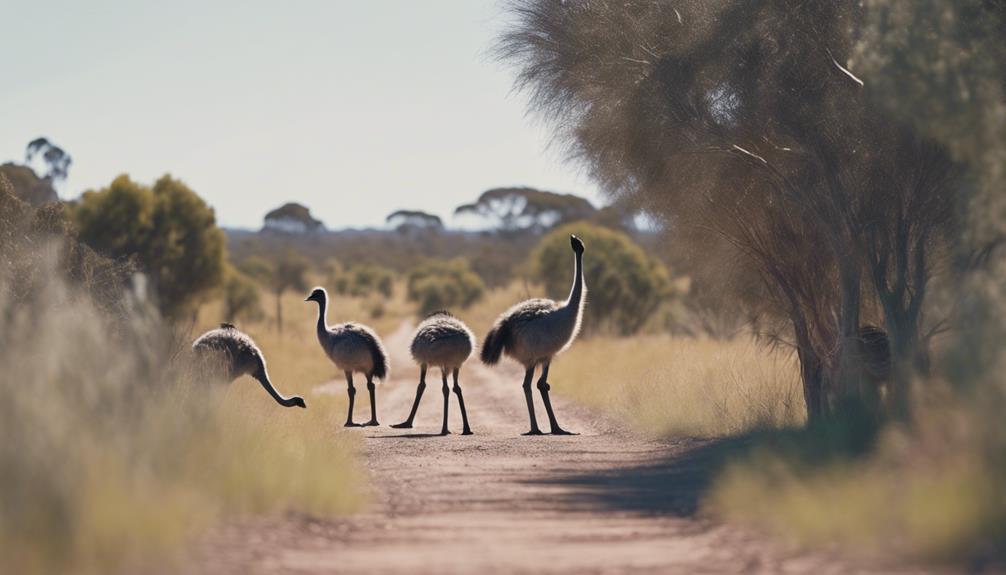
To safeguard emus from predators, it's essential to understand the various threats they face in their natural habitat. Identifying these predators is just the first step towards implementing effective protection measures. From physical barriers to innovative deterrents, a range of strategies can be employed to mitigate predation risks. By exploring the intricacies of predator-prey dynamics and the ongoing efforts to secure emu populations, you'll gain valuable insights into the challenges and solutions involved in this critical conservation endeavor.
Key Takeaways
- Implement electric fencing as a non-lethal barrier against predators.
- Use guardian animals like dogs or llamas to deter potential threats.
- Deploy visual and auditory deterrents to discourage predator attacks.
- Utilize trapping techniques to manage predator populations effectively.
- Establish wildlife corridors for safe movement and protection of emus.
Predator Identification
To effectively protect emus from predators, it's crucial to accurately identify the specific threats they face in their environment. Emus, being large flightless birds, are vulnerable to a range of predators, both natural and introduced. Common natural predators of emus include dingoes, wedge-tailed eagles, and feral pigs. Dingoes are known to target emu chicks and weak adults, posing a significant threat to the emu population. On the other hand, wedge-tailed eagles primarily prey on young emus. Feral pigs are opportunistic omnivores that may scavenge emu eggs or target adult emus.
In addition to natural predators, introduced predators such as foxes and dogs also pose a serious risk to emus. Foxes are adept hunters and can decimate emu populations if left unchecked. Dogs, whether they're feral or domestic, can harass and kill emus, especially during breeding seasons. Understanding the predatory threats faced by emus is essential in developing effective conservation strategies to mitigate these risks and ensure the survival of these majestic birds in their natural habitat.
Habitat Modification
Habitat modification techniques can be implemented to enhance the security and sustainability of emu populations in the face of predatory threats. By altering the landscape to create natural barriers or safe zones, the risk of predation on emus can be significantly reduced.
One effective method is the strategic placement of dense shrubbery and vegetation to provide cover and hiding spots for emus, making it harder for predators to approach undetected. Additionally, creating open areas with high visibility can help emus detect predators from a distance, allowing them to flee to safety in time.
Moreover, managing water sources within emu habitats is crucial. By ensuring that water points are located in open areas with clear lines of sight, emus can quench their thirst while staying vigilant for potential threats.
Proper habitat modification not only decreases the vulnerability of emus to predators but also promotes a more balanced ecosystem where these majestic birds can thrive. Conservation efforts focused on habitat enhancement play a pivotal role in safeguarding emu populations for future generations.
Electric Fencing

In enhancing the security measures for emu populations against predators, implementing electric fencing is a proven method to establish a robust deterrent system. Electric fencing delivers a powerful shock upon contact, effectively deterring predators from accessing emu habitats. The electric shock is safe yet potent enough to dissuade animals like foxes, dingoes, or feral dogs. Here is a breakdown of the benefits of electric fencing for protecting emus:
| Electric Fencing Benefits | Description |
|---|---|
| Enhanced Security | Creates a strong barrier against predators. |
| Non-Lethal Deterrent | Safely discourages predators without causing harm. |
| Low Maintenance | Requires minimal upkeep once installed. |
The data shows that electric fencing is a reliable tool in safeguarding emu populations. By investing in this technology, you can significantly reduce the risks posed by predators to these magnificent birds.
Guardian Animals
Guardian animals play a crucial role in defending emu populations against predatory threats, contributing significantly to the overall security of these birds. The presence of guardian animals, such as dogs or llamas, can act as a deterrent to potential predators, reducing the risk of emu depredation. Studies have shown that livestock guardian dogs, for example, have been effective in protecting not only livestock but also ostriches, emus, and other large birds from predators like coyotes and foxes.
These guardian animals leverage their natural instincts and behaviors to patrol the perimeter, detect intruders, and alert the emus to potential dangers. Their mere presence can create a protective barrier that predators are less likely to breach. By forming a symbiotic relationship with emus, guardian animals help create a safer environment for the birds to thrive and reproduce.
Incorporating guardian animals into emu farming practices can be a cost-effective and environmentally friendly method to enhance the security of emu populations without resorting to lethal means of predator control. The strategic deployment of guardian animals can play a vital role in ensuring the long-term survival of emus in their natural habitats.
Predator Deterrents

To enhance emu populations' protection against predators, implementing effective predator deterrents is imperative to mitigate potential threats. Predator deterrents play a crucial role in reducing predation pressure on emus, ultimately aiding in the conservation of these magnificent birds.
Research indicates that visual deterrents, such as predator decoys or scarecrows strategically placed in emu habitats, can effectively deter predators by creating a sense of risk. Moreover, auditory deterrents, like predator alarm calls or distress signals, have shown promising results in disrupting predator behavior and reducing predation rates on emus.
Another successful predator deterrent is the use of fencing to create physical barriers between emus and potential predators. High-quality fencing, equipped with predator-proof features, has proven to be a robust defense mechanism against predatory threats. Additionally, employing motion-activated lights or sound devices can startle predators, deterring them from approaching emu habitats.
Trapping Techniques
Implementing strategic trapping techniques is essential in safeguarding emu populations from predatory threats. Trapping plays a crucial role in managing predator populations and reducing predation pressure on emus. One effective method is the use of box traps strategically placed in areas frequented by predators. These traps are designed to capture predators without causing them harm, allowing for their safe relocation away from emu habitats. By deploying these traps strategically, wildlife managers can target specific predator species known to pose a threat to emus.
Furthermore, the use of camera traps can aid in monitoring trap sites, providing valuable data on predator activity and behavior. This information is essential for fine-tuning trapping strategies and ensuring their effectiveness in protecting emus. Continuous monitoring and adjustment of trap locations based on data analysis are vital components of successful trapping programs.
Nighttime Monitoring

Strategically monitoring predator activity during nighttime hours is imperative for gaining insights into their behavior patterns and potential threats to emu populations. By employing advanced infrared cameras and motion sensors in key locations within emu habitats, researchers can effectively track nocturnal predators such as foxes, wild dogs, and feral cats. These monitoring efforts provide valuable data on the frequency of predator visits, their hunting behaviors, and the specific areas where emus are most vulnerable.
Analyzing the collected data allows conservationists to identify high-risk periods when predator activity peaks, enabling them to implement targeted protective measures during these critical times. Moreover, understanding predator behavior under the cover of darkness aids in developing more effective strategies to deter or mitigate threats to emu populations. By harnessing the power of technology and scientific monitoring techniques, conservation efforts can be refined and optimized to safeguard emus from nighttime predators, ultimately contributing to the long-term preservation of these majestic birds.
Community Involvement
Engaging the local community in conservation efforts plays a crucial role in enhancing the protection of emus from predators. When communities come together for this cause, the impact is profound. Here are ways in which community involvement strengthens emu protection:
- Increased Surveillance: Local residents can provide additional eyes and ears to monitor emu habitats.
- Raising Awareness: Community engagement serves as a platform to educate and inform others about the importance of emu conservation.
- Prompt Reporting: With community involvement, sightings of potential threats can be reported swiftly for timely action.
- Habitat Preservation: By involving the community, efforts to conserve and restore emu habitats are intensified.
- Collaborative Solutions: Communities often offer innovative ideas and solutions that can complement existing conservation strategies.
Harnessing the power of community involvement fosters a sense of responsibility and ownership towards protecting emus, leading to a more robust defense against predators. By uniting people under a common goal, the conservation of emus is fortified, ensuring the continued survival of these magnificent creatures.
Predator-Proof Enclosures

To fortify emu protection against predators, constructing predator-proof enclosures is imperative for safeguarding these vulnerable birds. These enclosures must be meticulously designed to withstand the cunning strategies of predators seeking to harm emus. Utilizing strong materials such as reinforced steel and durable mesh can effectively deter intrusions. The design should incorporate underground barriers to prevent burrowing predators from gaining access. Additionally, implementing a secure gating system with automatic locks can further enhance the enclosure's effectiveness.
Studies have shown that predator-proof enclosures significantly reduce emu mortality rates caused by predation. By creating these fortified spaces, emus can thrive in a safer environment, allowing for population growth and species conservation. The strategic placement of these enclosures within emu habitats can create safe zones where emus can feed, nest, and raise their young without constant threat.
Investing in predator-proof enclosures showcases a commitment to protecting emus and promoting biodiversity. These structures serve as a powerful defense mechanism against predators, ensuring the long-term survival of emu populations.
Alarm Systems
Implementing alarm systems within predator-proof enclosures enhances emu protection by providing early warning alerts of potential threats. These systems are crucial in safeguarding the emus from harm and ensuring their survival. Here are some key points to consider about alarm systems:
- Immediate Detection: Alarm systems can swiftly detect any disturbances in the enclosure, alerting caretakers promptly.
- 24/7 Monitoring: The systems provide round-the-clock surveillance, offering continuous protection for the emus.
- Customizable Alerts: Alerts can be customized to differentiate between minor disturbances and serious threats, optimizing response times.
- Integration with Cameras: Alarm systems can be integrated with surveillance cameras for visual confirmation of potential dangers.
- Data Analysis: They collect data on intrusion patterns, helping in refining security measures for better emu protection.
Wildlife Corridors

Utilize wildlife corridors strategically to facilitate safe movement for emus and mitigate potential encounters with predators. Wildlife corridors serve as vital pathways for emus to navigate their habitats while minimizing risks associated with predators. By carefully planning and implementing wildlife corridors, you can effectively enhance the safety and survival rates of emu populations in predator-rich environments.
Scientific research has shown that well-designed wildlife corridors can significantly reduce the likelihood of emus falling prey to predators. These corridors act as protective channels, allowing emus to move between essential resources such as feeding and breeding grounds without exposing themselves to excessive danger. Through the strategic placement of wildlife corridors, you can create a network that not only safeguards emus but also benefits other wildlife species in the ecosystem.
Conservation efforts focused on establishing and maintaining wildlife corridors are crucial for the long-term protection of emu populations. These corridors play a pivotal role in preserving biodiversity and promoting ecological balance by facilitating the movement of emus and other animals in a secure environment. By prioritizing the establishment of wildlife corridors, you can contribute significantly to the conservation of emus and the overall health of their habitats.
Research and Monitoring
Research and monitoring of emu populations are essential components in understanding their behavior, ecology, and interactions with predators in their natural habitat. To ensure the protection and conservation of these majestic birds, consider the following:
- GPS Tracking: Utilize GPS technology to monitor emu movements and identify high-risk areas for predation.
- Camera Traps: Set up camera traps to observe predator behavior and assess the effectiveness of current protective measures.
- Population Surveys: Conduct regular population surveys to track emu numbers and detect any concerning trends.
- Behavioral Studies: Investigate emu behavior patterns to pinpoint vulnerabilities and develop targeted intervention strategies.
- Predator-Prey Dynamics: Study the dynamics between emus and their predators to implement informed predator management strategies.
Frequently Asked Questions
How Do Emus Protect Their Eggs From Predators?
You protect your eggs by camouflaging them in the surroundings, making them hard to spot. You also employ strategic nesting locations, such as dense vegetation, to shield your precious eggs from potential predators.
Can Emus Coexist With Other Livestock Animals?
You can observe that emus can peacefully coexist with other livestock animals. Studies indicate that proper management practices, including suitable space allocation and social dynamics, contribute to successful cohabitation. This harmonious relationship benefits all involved parties.
Do Emus Have Natural Defense Mechanisms Against Predators?
Emus possess unique adaptations to evade predators. Their powerful legs enable swift running up to 30 mph, while sharp claws can deliver forceful kicks. Additionally, keen eyesight and hearing aid in detecting threats, enhancing survival chances.
What Are the Legal Implications of Harming Emu Predators?
If you're wondering about the legal implications of harming emu predators, it's crucial to understand the delicate balance of ecosystems. Regulations aim to protect biodiversity and prevent disruptions that could have cascading effects on the environment.
Are There Any Long-Term Effects on Emus From Predator Encounters?
Encounters with predators can have long-term effects on emus, impacting their stress levels, reproductive success, and overall population dynamics. Understanding these consequences is crucial for effective conservation strategies and ecosystem management.
Conclusion
As you step back and observe the intricate dance of predator and prey in the emu's world, remember that conservation efforts are like the gentle hand guiding a delicate marionette.
By employing innovative strategies and unwavering dedication, we can weave a tapestry of protection for these majestic creatures.
Let the threads of science and data intertwine, creating a harmonious symphony of safeguarding emus from their predators, ensuring their survival for generations to come.





